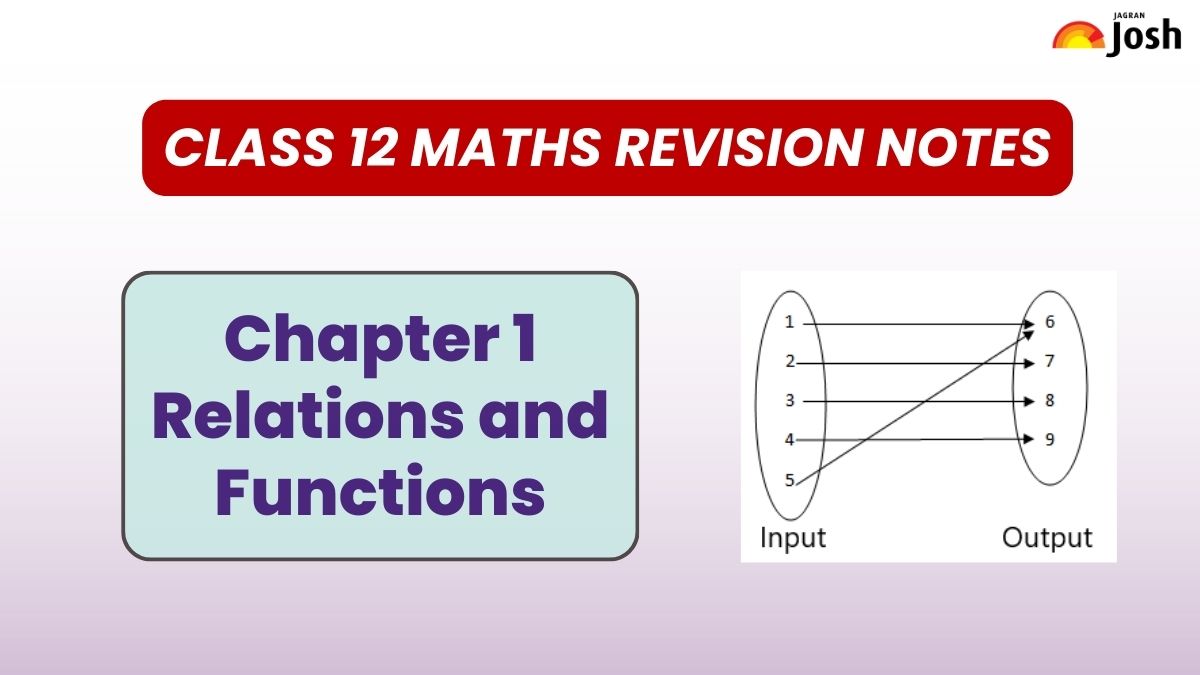APPSC Group 2 Answer Key 2024 Out at psc.ap.gov.in: Here’s Download Link
[ad_1] APPSC Group 2 Answer Key 2024 Out: The Andhra Pradesh Public Service Commission (APPSC)…
[ad_1]

Relation
If A and B are two non-empty sets, then a relation R from A to B is a subset of A x B.
If R ⊆ A x B and (a, b) ∈ R, then we say that a is related to b by the relation R, written as aRb.
Domain and Range of a Relation
Let R be a relation from a set A to set B. Then, set of all first components or coordinates of the ordered pairs belonging to R is called the domain of R, while the set of all second components or coordinates = of the ordered pairs belonging to R is called the range of R.
Thus, domain of R = {a : (a , b) ∈ R} and range of R = {b : (a, b) ∈ R}
Empty relation is the relation R in X given by R = φ ⊂ X × X.
Universal relation is the relation R in X given by R = X × X.
Reflexive relation R in X is a relation with (a, a) ∈ R ∀ a ∈ X.
Symmetric relation R in X is a relation satisfying (a, b) ∈ R implies (b, a) ∈ R.
Transitive relation R in X is a relation satisfying (a, b) ∈ R and (b, c) ∈ R implies that (a, c) ∈ R.
Equivalence relation R in X is a relation that is reflexive, symmetric and transitive.
Equivalence class [a] containing a ∈ X for an equivalence relation R in X is the subset of X containing all elements b related to a.
A function f : X → Y is one-one (or injective) if
f(x1) = f(x2) ⇒ x1 = x2 ∀ x1, x2 ∈ X.
A function f : X → Y is onto (or subjective) if given any y ∈ Y, ∃ x ∈ X such that f(x) = y.
A function f : X → Y is one-one and onto (or bijective), if f is both one-one and onto.
Given a finite set X, a function f : X → X is one-one (respectively onto) if and only if f is onto (respectively one-one). This is the characteristic property of a finite set. This is not true for infinite set.
Question 1: Find out whether each of the following relations are reflexive, symmetric and transitive.
(i) Relation R in the set A = {1, 2, 3…13, 14} defined as
R = {(x, y): 3x − y = 0}
(ii) Relation R in the set N of natural numbers defined as
R = {(x, y): y = x + 5 and x < 4}
(iii) Relation R in the set A = {1, 2, 3, 4, 5, 6} as
R = {(x, y): y is divisible by x}
Answer:
(i) A = {1, 2, 3 … 13, 14}
R = {(x, y): 3x − y = 0}
∴R = {(1, 3), (2, 6), (3, 9), (4, 12)}
R is not reflexive since (1, 1), (2, 2) … (14, 14) ∉ R.
Also, R is not symmetric as (1, 3) ∈R, but (3, 1) ∉ R. [3(3) − 1 ≠ 0]
Also, R is not transitive as (1, 3), (3, 9) ∈R, but (1, 9) ∉ R.
[3(1) − 9 ≠ 0]
Hence, R is neither reflexive, nor symmetric, nor transitive.
(ii) R = {(x, y): y = x + 5 and x < 4} = {(1, 6), (2, 7), (3, 8)}
It is seen that (1, 1) ∉ R.
∴R is not reflexive. (1, 6) ∈R
But,(6, 1) ∉ R.
∴R is not symmetric.
Now, since there is no pair in R such that (x, y) and (y, z) ∈R, then (x, z) cannot belong to R.
∴ R is not transitive.
Hence, R is neither reflexive, nor symmetric, nor transitive.
(iii) A = {1, 2, 3, 4, 5, 6}
R = {(x, y): y is divisible by x}
We know that any number (x) is divisible by itself.
(x, x) ∈R
∴R is reflexive.
Now, (2, 4) ∈R [as 4 is divisible by 2]
But, (4, 2) ∉ R. [as 2 is not divisible by 4]
∴R is not symmetric.
Let (x, y), (y, z) ∈ R. Then, y is divisible by x and z is divisible by y.
∴z is divisible by x.
⇒ (x, z) ∈R
∴R is transitive.
Hence, R is reflexive and transitive but not symmetric.
[ad_2]
Source link